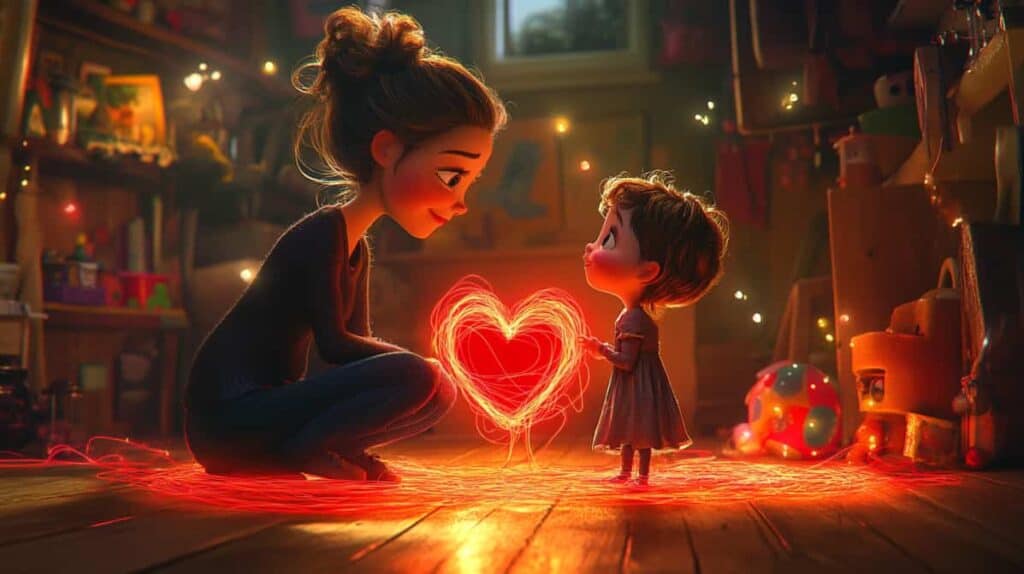I'attachment, this invisible bond that unites parents and children, has fascinated researchers for decades. At the heart of this exploration is the attachment theory, A paradigm revolutionary that illuminates our understanding of emotional development toddlers. Imagined by the British psychoanalyst John Bowlby and refined by his colleague Mary Ainsworth, this theory highlights the crucial importance of the first relationships in the construction of our emotional world.
As a careful gardener cultivates his plants, parents nourish the emotional security of their child, thus creating a solid base for its future development. But be careful, cultivating attachment is not an exact science! It is a subtle mixture of instinct, love and sometimes… clumsy fumbling. So, ready to dive into the twists and turns of this link so special? Fasten your (emotional) seatbelts, we're going to explore the secrets of the attachment theory and discover how it can transform your approach to parenthood !
The Foundations of Attachment Theory
Imagine for a moment that your child is a budding little explorer, ready to conquer the world. The attachment theory tells us that you, dear parents, are his security base, his base camp if you prefer. It is from this base that your little adventurer will be able to set off to discover his environment, knowing that he can come back to you at any time to recharge his batteries.
This theory, born in the 1950s, has revolutionized our understanding of emotional development children. It teaches us that the quality of the first relationships has a profound impact on how we interact with the world throughout our lives.
Did you know that babies are born with a veritable "emotional survival kit"? Yes, the tears, the smiles, and even that adorable way they have of clinging to us are all attachment behaviors innately intended to maintain proximity with their attachment figures.
A fascinating and sometimes controversial concept in attachment theory is that of monotropy. Proposed by John Bowlby, this term refers to the tendency of babies to attaching primarily to a single attachment figure, usually the mother. However, don't get me wrong! This does not mean that other relationships are not important.
There monotropy simply suggests a hierarchy in attachments, with a primary figure and other secondary figures. It's a bit like having a best friend while enjoying other friends. This idea has sparked much debate and evolved over time, recognizing the importance of multiple attachments in child development.

The different attachment patterns
As in any good theory, there are categories! Mary Ainsworth has identified several attachment patterns :
- I'secure attachment : the holy grail of the parent-child relationship. These children trust their security base and dare to explore the world.
- I'insecure attachment : which comes in several flavors, like a slightly anxiety-inducing ice cream parlor menu:
- Anxious-ambivalent: “I love you, me neither”
- Avoidant: “I’m a lone wolf (but deep down, I need you)”
- Disorganized: “I don’t know where to turn”
But be careful, these patterns are not indelible labels! They can change with time and experiences.
Parental Sensitivity: Your Hidden Superpower
In the heart of the attachment theory There is a key concept: the parental sensitivity. It is your ability to perceive, interpret and respond appropriately to your child's signals. Think of it as a silent dialogue, a subtle dance between you and your little one.
Here's a well-kept secret: You don't have to be perfect to develop a secure attachment ! The key is to be good enough, often enough. That's reassuring, isn't it?
There parental sensitivity is cultivated daily, through a thousand and one small gestures:
- Responding to Your Baby's Cries (No, You're Not Spoiling Him!)
- Providing comfort in times of distress
- Encourage exploration while remaining available
It's a real balancing act, between protection and encouragement of autonomy. But don't worry, with practice, you will become a true virtuoso of parenting!

Attachment through the ages: a long journey
Attachment is not just a baby thing! It is a process that continues throughout life. operating internal models, a kind of mental map of our relationships, are built from early childhood and influence our future interactions.
Here is a chart that illustrates how attachment changes with age:
| Age | Characteristics of attachment |
|---|---|
| 0 – 2 years | Formation of first links, search for physical proximity |
| 2 – 6 years | Development of autonomy, the security base remains essential |
| 6 – 12 years old | Expanding the social circle, parents remain a reference |
| Adolescence | Questioning, seeking independence |
| Adulthood | Transfer of attachment patterns in romantic and friendly relationships |
Isn't it fascinating how these early connections shape a whole life?
Attachment theory in everyday life: concrete ideas
Now that we’ve covered the theory, let’s move on to practice! Here are some ideas for cultivating secure attachment in everyday life:
- Practice active listening : show your child that you are really present and attentive.
- Establish rituals : they create a reassuring structure and strengthen bonds.
- Accept all emotions : even anger and fear have their place.
- Encourage exploration : be the safe base that enables adventure.
- Take care of yourself : a fulfilled parent is more likely to provide a secure attachment.
Remember that there is no such thing as perfection in parenting. The most important thing is to be present, attentive and caring, while allowing yourself a few missteps (which are all learning opportunities).
There attachment theory reminds us that parenthood is a journey, not a destination. So enjoy every step, every hug, every laugh. It’s in these moments that the strongest bonds are formed.
FAQ: Your questions about attachment theory
No, the child can develop an attachment with several figures, including the father, grandparents or people who regularly take care of him.
Yes, with patience and work on yourself, it is possible to evolve towards a more secure attachment, at any age.
Babywearing can indeed promote physical and emotional closeness, but it is not the only way to develop a secure attachment.
A child with a secure attachment explores his environment with confidence, knowing that he can come back to you if needed.
Although the basic principles are widely recognized, their expression may vary across cultures and parenting practices.
